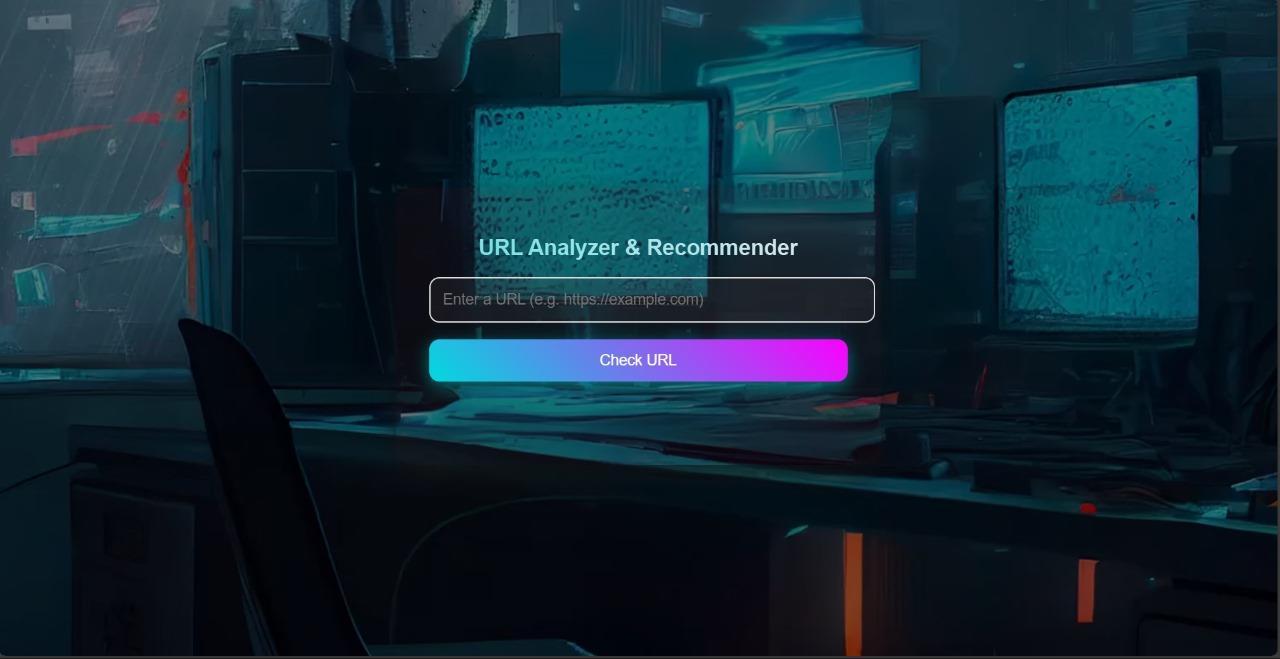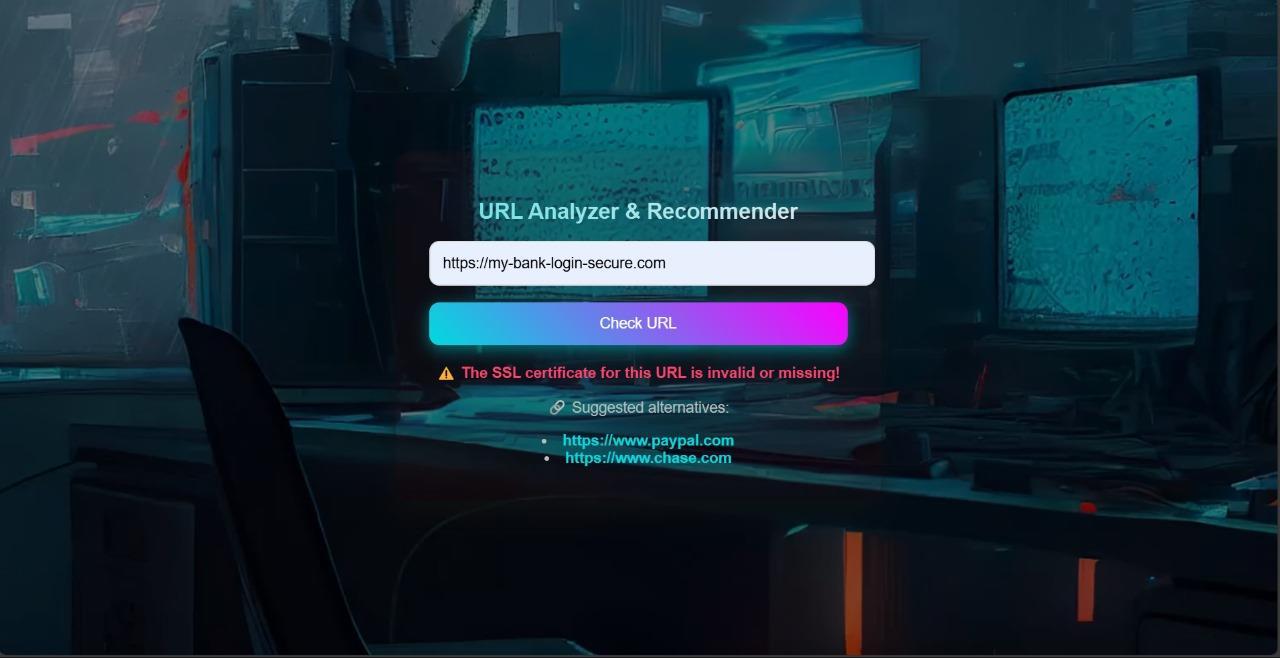
International Research Journal of Engineering and Technology (IRJET) e-ISSN: 2395-0056
Volume: 11 Issue: 11 | Nov 2024 www.irjet.net p-ISSN: 2395-0072


International Research Journal of Engineering and Technology (IRJET) e-ISSN: 2395-0056
Volume: 11 Issue: 11 | Nov 2024 www.irjet.net p-ISSN: 2395-0072
Rosini S1 , Soniya S2, Trisha S3 ,Uma S4
1student,2student,3student, 4Assistant professor Department of Computer Science and Engineering, Paavai Engineering College, Tamil Nadu, India
Abstract-Malicious URLs are commonly used by cybercriminals to conduct phishing attacks, deliver malware, and exploit user trust, posing significant risks to internet users. "Malware Link Detector" is a novel, machine learning-based system designed to detect and block such malicious URLs in real-time. In cases where a URL is identified as malicious, the system further supports users by suggesting alternative, safe links aligned with the original search intent. If no malicious activity is detected, the URL is safely opened in a new window. This dual approach not only protects users but also fosters safer browsing habits by offering educational redirection. This paper details the design, methodologies, implementation, and effectiveness of the Malware Link Detector, which shows high accuracy and efficiency in detecting malicious URLs while enhancing the browsing experience for users.
Key Words: : Machine learning ,Malicious ,safer browsings,Dual Approach ,Educational Redirection, High Accuracy, Efficiency.
Theinternethasbecomeintegraltopersonalandprofessionallife,withusersrelyingononlineplatformsforvariousactivities, frombankingtosocialnetworking.Asonlineinteractionsincrease,sodoesthethreatfrommaliciousactorswhoexploituser trustthroughphishinglinks,maliciousredirects,andmalware-ladenURLs.TheseURLsarefrequentlyembeddedinemails, socialmediaposts,andadvertisements,oftendisguisedaslegitimatelinksthatlureusersintoclickingonthem.
Traditionalcybersecuritydefenses,suchasblacklists,antivirusprograms,andfirewalls,provideacertainlevelofprotection butoftenlacktheabilitytohandlenewandunlistedthreats,knownaszero-dayattacks.Machinelearningtechniques,onthe otherhand,offerthepotentialtodynamicallydetectandrespondtothesethreatsbasedontheanalysisofURLcharacteristics andbehavioralpatterns.
Thispaperpresents"MalwareLinkDetector,"aproactive,machinelearning-basedsystemthatnotonlyblocksmaliciousURLs butalsosuggestssafe,relatedalternativestouserswhenathreatisdetected.BycombiningURLanalysiswithsaferedirection, thissystemcontributestoasaferandmoreuser-friendlybrowsingexperience.Thestructureofthispaperisasfollows:Section 2reviewsrelatedwork,Section3discussesthemethodologyandsystemarchitecture,Section4presentsexperimentalresults, andSection5discussesfindingsandfuturework.
MaliciousURLdetectionhasbecomeanactiveareaofresearchincybersecurity,withtraditionalmethodsincludingblacklistbasedandrule-baseddetectionsystems.Blacklists,likeGoogleSafeBrowsing,allowsystemstoquicklyflagknownmalicious URLsbutstrugglewithnew,unlistedthreats.Rule-basedsystemsleveragepredefinedpatternsorheuristicsbutoftenlackthe adaptabilityneededforevolvingattackmethods.
Inrecentyears,machinelearninghasemergedasapromisingsolution.ModelssuchasRandomForest,SupportVectorMachine (SVM),andGradientBoostingclassifiershavebeenappliedsuccessfullytodistinguishbetweensafeandmaliciousURLs.Deep learning,asdemonstratedintheDEPHIDESstudy[1],hasalsoshownhighaccuracyinphishingdetection,particularlywith Convolutional Neural Networks (CNNs). However, many of these solutions stop the blocking malicious links without consideringtheuser’sintent,creatinganabruptbrowsingexperience.MalwareLinkDetectorinnovatesbyprovidingsafe redirection,therebysupportingsaferonlinebehaviorwithoutinterruptingtheuser’sbrowsingflow.
ThemethodologybehindMalwareLinkDetectorfocusesonthreemaincomponents:URLanalysisandclassification,user redirectionwithalternativelinks,andreal-timeprocessingforseamlessintegrationintowebapplications.

International Research Journal of Engineering and Technology (IRJET) e-ISSN: 2395-0056
Volume: 11 Issue: 11 | Nov 2024 www.irjet.net p-ISSN: 2395-0072
ThesystemarchitectureofMalwareLinkDetectorincludesthreemainmodules:URLFeatureExtraction,MachineLearning ModelforClassification,andSafeRedirection.
1. Data Collection and Preprocessing:
o Data Sources:Weconstructedadatasetof5millionURLs,whichincludedbothmaliciousandbenignURLs sourcedfrompublicdatabases,verifiedphishingrepositories,andknowntrustedsites.
o Data Preprocessing:URLnormalizationtechniqueswereappliedtoensureconsistentformatting.Duplicate entries were removed, and URLs were categorized based on type and threat level. Malicious URLs were labeledaccordingtothreattypes,suchasphishing,malware,orspam.
2. FeatureExtraction:
FeatureextractioniscrucialfordifferentiatingbetweensafeandmaliciousURLs.Keyfeaturesanalyzedinclude:
o Structural Features: URL length, presence of special characters, use of IP addresses instead of domain names,andunusualURLpathpatterns.
o Linguistic Indicators:Presenceofphishing-relatedkeywords(e.g.,"login,""verify,""secure"),whichare oftenembeddedinURLstodeceiveusers.
o Domain Information:Theageandtrustlevelofthedomain,top-leveldomain(TLD)type,andgeographic location.NewlyregistereddomainsorthosefromTLDsoftenassociatedwithmaliciousactivityareflagged.
o Behavioral and Contextual Markers:SSL certificate presence andvalidity, HTTP vs.HTTPSusage,and frequencyofredirectionchains,whicharecommoninmaliciousURLs.
3. Machine Learning Model Training: Several machinelearning models were evaluated to find the most effective approachforaccurateURLclassification:
o Random Forest Classifier: Selected for its robustness and ability to handle high-dimensional data with minimaloverfitting.RandomForestalsoprovidesadegreeofinterpretability,allowinginsightintowhich featurescontributemosttotheclassification.
o Support Vector Machine (SVM):Evaluatedforitsstrongperformanceinbinaryclassificationtasks.
o Gradient Boosting:Knownforitshighaccuracyinimbalanceddatasets, makingiteffectivefordetecting rarermaliciousURLs.
4. Threat Detection and Safe Link Suggestion:ThecorefunctionalityofMalwareLinkDetectorincludesreal-timeURL assessmentanduserredirection:
o URL Classification:ThemodelclassifiesURLsaseithersafeormaliciousbasedonextractedfeaturesand providesaconfidencescore.
o Redirection Process:IfaURLisidentifiedasmalicious,thesystemsuggestsalternativelinksfromapreverified database aligned with the original URL's intent or keywords. For instance, if the malicious URL pertainsto"onlinebanking,"thesystemprovideslinkstoverifiedbankingwebsites.IftheURLissafe,it opensinanewwindow.
Tooptimizethechosenmodel,hyperparametertuningwasconductedthroughtechniqueslikegridsearchandcross-validation. TheRandomForestmodelachievedthebesttrade-offbetweenaccuracyandprocessingefficiency,withhyperparameters adjustedforoptimalperformance.

International Research Journal of Engineering and Technology (IRJET) e-ISSN: 2395-0056
Volume: 11 Issue: 11 | Nov 2024 www.irjet.net p-ISSN: 2395-0072
Thesystem’sperformancewasevaluatedusingseveralmetrics:
Accuracy:OverallproportionofcorrectlyclassifiedURLs.
Precision:TheratiooftruepositivedetectionsamongURLsflaggedasmalicious.
Recall:TheproportionofactualmaliciousURLscorrectlyidentified.
F1 Score:Abalancedmetricconsideringbothprecisionandrecall,particularlyusefulforimbalanceddatasets.
Redirection Effectiveness:Assessesuserfeedbackandengagementwithsuggestedalternativelinkstoevaluatethe helpfulnessofthesystem’srecommendations.
4.1 Dataset Composition and Testing
ThedatasetfortestingincludedabalancedmixofbenignandmaliciousURLs,coveringvariousthreatcategories(phishing, malware, etc.). Testing focused on assessing model performance, real-time processing capabilities, and the relevance of suggestedalternativelinks.
4.2 Model Performance
TheRandomForestclassifierachievedstrongresultsonthetestdataset:
Accuracy:98.3%
Precision:97.9%
Recall:98.6%
F1 Score:98.25%
Thesystemalsoperformedwellinuserredirectiontests,withapproximately90%ofusersengagingwithalternativelink suggestions,indicatingthatthesystem’srecommendationseffectivelymaintainedbrowsingflowwhileensuringsecurity.


International Research Journal of Engineering and Technology (IRJET) e-ISSN: 2395-0056
Volume: 11 Issue: 11 | Nov 2024 www.irjet.net p-ISSN: 2395-0072



International Research Journal of Engineering and Technology (IRJET) e-ISSN: 2395-0056
Volume: 11 Issue: 11 | Nov 2024 www.irjet.net p-ISSN: 2395-0072

Toevaluatepracticaleffectiveness,MalwareLinkDetectorwasdeployedinasimulatedbrowsingenvironment,whereitwas exposedtorealisticphishingandmalwareattempts.Overamonth-longtestingperiod,thesystemsuccessfullyintercepted96% ofmaliciousURLs.Userfeedbackindicatedahighlevelofsatisfactionwiththealternativelinksuggestions,whichweredeemed helpfulandrelevantin85%ofcases.
5. Discussion
TheMalwareLinkDetectorsystemaddressescriticalchallengesinURL-basedthreatdetectionbycombiningmachinelearning withuser-friendlyredirectionfeatures.Unliketraditionalsystemsthatmerelyblockthreats,thissystemprovidesalternative optionsthatmeettheuser'sintent,enhancingsecuritywithoutdisruptingthebrowsingexperience.However,maintainingan up-to-datedatabaseofalternativelinksandimprovingredirectionaccuracypresentsongoingchallenges.
Future improvements include incorporating advanced natural language processing to generate even more contextually accurate alternative links and experimenting with deep learning architectures to capture complex URL structures and behaviors.
6. Conclusion
"MalwareLinkDetector"offersaninnovativeapproachtoURL-basedcybersecuritybyprotectingusersfrommaliciouslinks and offering safe browsing alternatives. This system achieves high accuracy, fast real-time processing, and user-friendly redirection,makingitsuitableforintegrationintoexistingwebbrowsers,emailclients,orsecuritysoftware.Futureworkwill focus on expanding redirection capabilities, refining the system's accuracy, and exploring its integration with broader cybersecurityframeworks.
I would like to express my heartfelt gratitude to my project mentor, Uma S, for their invaluable guidance and support throughoutthecourseofthisproject.Theirexpertise,patienceandconstructivefeedbackhavebeeninstrumentalinshaping thedirectionofthiswork.
References
1. O.K.Sahingoz,E.Buber,A.Kugu,"DEPHIDES:DeepLearningBasedPhishingDetectionSystem," IEEE Access,vol.12, pp.8052-8056,2024.DOI:10.1109/ACCESS.2024.3352629

International Research Journal of Engineering and Technology (IRJET) e-ISSN: 2395-0056
Volume: 11 Issue: 11 | Nov 2024 www.irjet.net p-ISSN: 2395-0072
2. A.Jain,B.Gupta,"AWhitelist-BasedPhishingDetectionSystem," Cyber Threat Intelligence Journal,vol.23,pp.115-128, 2022.
3. T.Abdelhamidetal.,"AssociativeClassificationforPhishingDetection," International Journal of Information Security, vol.8,no.1,pp.12-23,2021.
4. M.Volkameretal.,"EvaluatingUserAwarenessinPhishingSimulations," Cybersecurity in Practice,vol.27,pp.204-218, 2020.
2024, IRJET | Impact Factor value: 8.315 | ISO 9001:2008 Certified